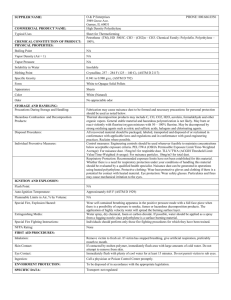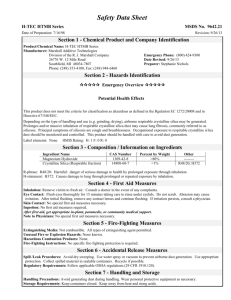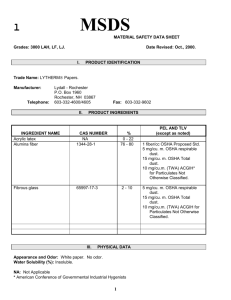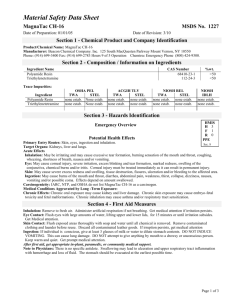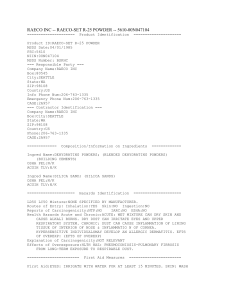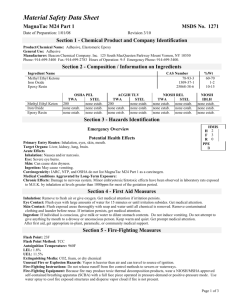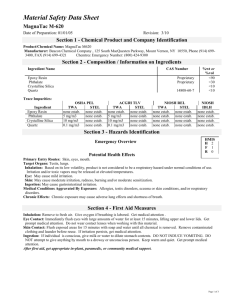TSCA - The RJ Marshall Company
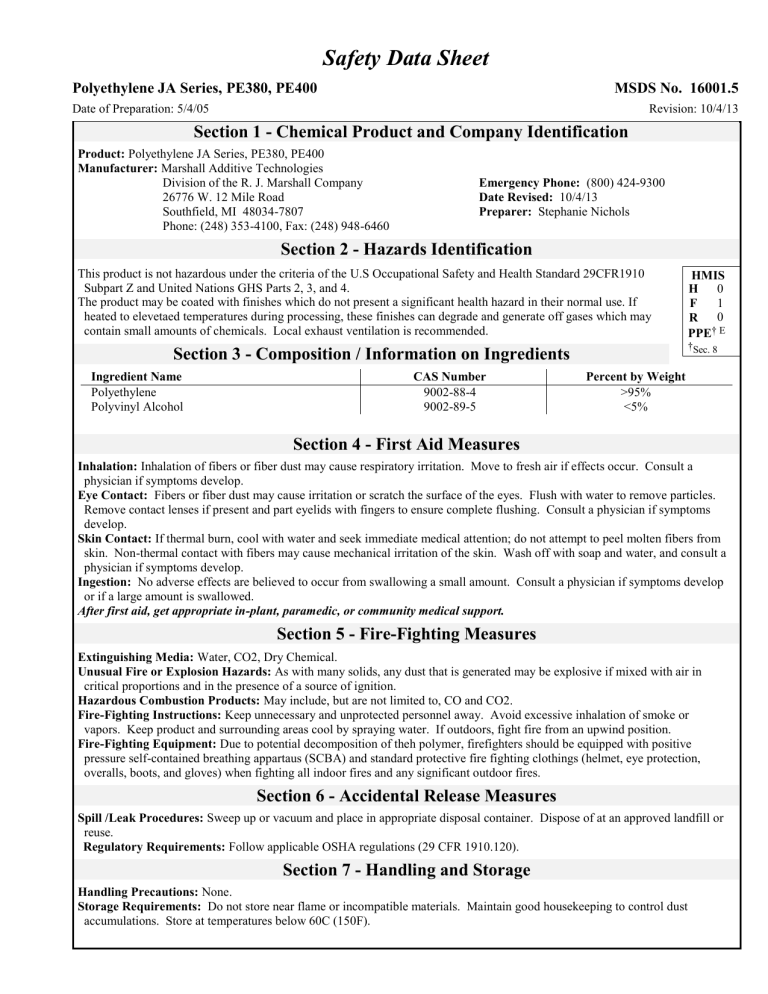
Safety Data Sheet
Polyethylene JA Series, PE380, PE400
Date of Preparation: 5/4/05
MSDS No. 16001.5
Revision: 10/4/13
Section 1 - Chemical Product and Company Identification
Product: Polyethylene JA Series, PE380, PE400
Manufacturer: Marshall Additive Technologies
Division of the R. J. Marshall Company
26776 W. 12 Mile Road
Southfield, MI 48034-7807
Phone: (248) 353-4100, Fax: (248) 948-6460
Emergency Phone: (800) 424-9300
Date Revised: 10/4/13
Preparer: Stephanie Nichols
Section 2 - Hazards Identification
This product is not hazardous under the criteria of the U.S Occupational Safety and Health Standard 29CFR1910
Subpart Z and United Nations GHS Parts 2, 3, and 4.
The product may be coated with finishes which do not present a significant health hazard in their normal use. If heated to elevetaed temperatures during processing, these finishes can degrade and generate off gases which may contain small amounts of chemicals. Local exhaust ventilation is recommended.
HMIS
H 0
F 1
R 0
PPE
†
† E
Sec. 8
Section 3 - Composition / Information on Ingredients
Ingredient Name
Polyethylene
Polyvinyl Alcohol
CAS Number
9002-88-4
9002-89-5
Percent by Weight
>95%
<5%
Section 4 - First Aid Measures
Inhalation: Inhalation of fibers or fiber dust may cause respiratory irritation. Move to fresh air if effects occur. Consult a physician if symptoms develop.
Eye Contact: Fibers or fiber dust may cause irritation or scratch the surface of the eyes. Flush with water to remove particles.
Remove contact lenses if present and part eyelids with fingers to ensure complete flushing. Consult a physician if symptoms develop.
Skin Contact: If thermal burn, cool with water and seek immediate medical attention; do not attempt to peel molten fibers from skin. Non-thermal contact with fibers may cause mechanical irritation of the skin. Wash off with soap and water, and consult a physician if symptoms develop.
Ingestion: No adverse effects are believed to occur from swallowing a small amount. Consult a physician if symptoms develop or if a large amount is swallowed.
After first aid, get appropriate in-plant, paramedic, or community medical support.
Section 5 - Fire-Fighting Measures
Extinguishing Media: Water, CO2, Dry Chemical.
Unusual Fire or Explosion Hazards: As with many solids, any dust that is generated may be explosive if mixed with air in critical proportions and in the presence of a source of ignition.
Hazardous Combustion Products: May include, but are not limited to, CO and CO2.
Fire-Fighting Instructions: Keep unnecessary and unprotected personnel away. Avoid excessive inhalation of smoke or vapors. Keep product and surrounding areas cool by spraying water. If outdoors, fight fire from an upwind position.
Fire-Fighting Equipment: Due to potential decomposition of theh polymer, firefighters should be equipped with positive pressure self-contained breathing appartaus (SCBA) and standard protective fire fighting clothings (helmet, eye protection, overalls, boots, and gloves) when fighting all indoor fires and any significant outdoor fires.
Section 6 - Accidental Release Measures
Spill /Leak Procedures: Sweep up or vacuum and place in appropriate disposal container. Dispose of at an approved landfill or reuse.
Regulatory Requirements: Follow applicable OSHA regulations (29 CFR 1910.120).
Section 7 - Handling and Storage
Handling Precautions: None.
Storage Requirements: Do not store near flame or incompatible materials. Maintain good housekeeping to control dust accumulations. Store at temperatures below 60C (150F).
revision_date 10/4/13 Polyethylene JA Series, PE380, PE400
Section 8 - Exposure Controls / Personal Protection
MSDS No. 16001.5
Engineering Controls:
Ventilation: Local exhaust for fiber dust only.
Administrative Controls:
Respiratory Protection: For operations where inhalation exposure can occur, a NIOSH approved respirator recommended by an industrial hygienist may be necessary.
Protective Clothing/Equipment: For operations where eye or face contact can occur, eye protection such as goggles or a face shield is recommended.
Ingredient
Polyethylene
OSHA PEL
TWA STEL none estab.
Polyvinyl Alcohol none estab. none estab. none estab.
ACGIH TLV
TWA none estab. none estab.
Fiber dust should be considered a nuisance dust, i.e. particulated not otherwise classified.
ACGIH TLV: 10mg/m 3 total dust; 3 mg/m 3 respirable dust
OSHA PEL: 15 mg/m 3 total dust; 5 mg/m 3 respirable dust
STEL none estab. none estab.
Section 9 - Physical and Chemical Properties
Physical State: solid
Appearance and Odor: white solid, no odor
Odor Threshold: n/e
Formula Weight: n/a
Density: n/a
Specific Gravity (H
2
O=1, at 4 ° C): 0.96 pH: no data available
Flash Point: >200C
Flash Point Method: n/a
Burning Rate: Not determined.
Auto-ignition Temperature: Not determined.
Flammability Classification: Non-flammable.
Water Solubility: Negligible
Other Solubilities: n/a
Boiling Point: n/a
Freezing/Melting Point: 135C (320F)
Viscosity: n/a
Refractive Index: n/a
Surface Tension: n/a
% Volatile: <2% (water)
Evaporation Rate: Negligible
Vapor Pressure: n/e
Vapor Density (Air=1): n/a
Decomposition Temp: No data available
Shelf Life: Does not expire
Section 10 - Stability and Reactivity
Reactivity: Data not available.
Stability: This product is stable at room temperature in closed containers under normal storage and handling conditions.
Polymerization: None anticipated under normal or recommended handling and storage conditions.
Chemical Incompatibilities: Tends to decompose in strong acids and bases.
Conditions to Avoid: Excessive heat shall be avoided. Small quantities of fumes are evolved at about 225C (435F). These gradually increase until at above 300C decomposition and oxidative pyrolysis take place. Above 300C the heat of oxidation may produce a rapid rise in temperature which accelerates the pyrolysis. Under these circumstances hazardous substances such as carbon monoxide, formaldehyde, and acrolein can be evolved.
Hazardous Decomposition Products: None anticipated under normal or recommended handling and storage conditions.
Page 2 of 4
revision_date 10/4/13 Polyethylene JA Series, PE380, PE400
Section 11- Toxicological Information
MSDS No. 16001.5
Health Hazards (Acute and Chronic): According to the hypothesis of Stanton-Pott, it is reported that there is a possibility of causing cancer when ultra-fine fibers below 0.25 um in diameter and above 8 um in length are absorbed into the lung. When this product was observed with the electron microscope, the diameter of the fibers was above 1 um and the average length was over 100 um; therefore the values were higher than those provided by this hypothesis. However, in the manufacturing process, the product may be reduced into ultra-fine fibers that come within the range presented in the Stanton-Pott hypothesis.
Carcinogenicity: NTP-not listed IARC: 3-not classifiable as to its carcinogenicity to humans. OSHA-not regulated.
Signs & Symptoms of exposure: No data available.
Medical Conditions Aggravated by Exposure: Some individuals, e.g. with asthma or bronchitis, are likely to be intolerant of high concentrations of airborne fibers or fiber dust when processing.
Section 12 - Ecological Information
Ecotoxicity: No data available.
Persistence and Biodegradibility: Fiber is not biodegradable.
Bioaccumulative Potential: No data available.
Mobility in Soil: No data available.
Section 13 - Disposal Considerations
Disposal: Dispose as non-hazardous solid waste in sanitary landfill or incinerate according to Federal, State, and local regulations. Do not incinerate closed containers.
Section 14 - Transport Information
DOT Transportation Data (49 CFR 172.101):
Polyethylene Pulp
NFMC No. 68310
Class: 100
HTC No. 3920.10
US DOT: Not regulated
ICAO/IATA: Not regulated
IMDG: Not regulated
Canada TDG: Not regulated
Section 15 - Regulatory Information
EPA Regulations:
RCRA Hazardous Waste Number: Not listed (40 CFR 261.33)
RCRA Hazardous Waste Classification: Not classified
CERCLA Hazardous Substance (40 CFR 302.4) Not listed
SARA Toxic Chemical (40 CFR 372.65): Not listed
SARA EHS (Extremely Hazardous Substance) (40 CFR 355): Not listed
OSHA Regulations:
Air Contaminant (29 CFR 1910.1000, Table Z-1, Z-1-A): Not listed
TSCA
This substance or all of its components are on the Chemical Substances Inventory of the Toxic Substance Control Act (TSCA
Inventory [USA]). Please note that this product is not subject to any legal reporting requirements under these acts.
State Regulations:
California: Proposition 65-Does not contain chemicals known to the State of California to cause cancer or reproductive toxicity.
International Regulations:
Canada WHMIS: Not a controlled product.
Canada DSL: This product, or all its ingredients, is certified for inclusion on the Canadian Domestic Substance List.
Europe: Not classified as dangerous according to Directive 1999/45/EC. This product is RoHS compliant.
UN: Does not appear on the dangerous goods list.
Page 3 of 4
revision_date 10/4/13 Polyethylene JA Series, PE380, PE400
Section 16 - Other Information
MSDS No. 16001.5
Prepared By: Stephanie Nichols
Revision Notes: Updated throughout.
Product Grades Available from the R. J. Marshall Company (this list may be incomplete):
24JA 25JA 26JA 27JA PE380 PE400
Disclaimer: Information contained herein is presented in good faith and is based on data believed to be accurate. However no warranty is expressed or implied regarding this information or the results obtained from the use of this Material Safety Data
Sheet, whether it originates with The R. J. Marshall Company or others. This Safety Data Sheet relates only to the specific material designated herein. It does not relate to use with other material or processes. This information is supplied with the condition that the user will make appropriate determination as to its suitability for their purpose prior to using it.
Page 4 of 4
